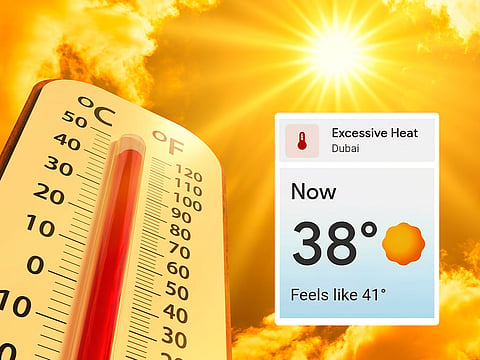'40°C but feel like 45°C': Why does it feel hotter than the actual temperature in UAE?
Understanding heat index: Why it's crucial to know beyond just temperature

Dubai: When stepping outside in the UAE during summer, you might notice something peculiar: the thermometer reads 40°C, but your body experiences what feels closer to 45°C or even higher. This phenomenon isn't your imagination – it's the result of the heat index, a critical weather measurement that determines how hot it actually feels to the human body.
What creates the Heat Index in UAE weather?
The UAE's National Center of Meteorology explains that the heat index, sometimes called the "discomfort index," combines actual air temperature with relative humidity levels to calculate the perceived temperature. This measurement is particularly relevant in the UAE's coastal climate, where humidity from the Arabian Gulf significantly impacts comfort levels.
The relationship works as follows: when air temperature sits at 40°C with low humidity around 20%, the outdoor experience matches the thermometer reading. However, when humidity climbs to 65-75%, that same 40°C temperature creates a sensation equivalent to 45°C or higher.
Currently, the UAE experiences relative humidity levels ranging from 50% to 90% during evening hours, especially along coastal regions. This elevated humidity can increase the perceived temperature by seven to nine degrees above actual readings.
How humidity affects your body's cooling system
The human body naturally cools itself through perspiration. When sweat evaporates from skin, it removes heat and lowers body temperature. However, high atmospheric moisture significantly reduces evaporation rates. In humid conditions, sweat cannot evaporate efficiently, preventing the body's natural cooling mechanism from working effectively.
This explains why UAE residents often feel uncomfortably warm even when temperatures aren't at their absolute peak. The body struggles to regulate its temperature in the moisture-rich air, creating that oppressive feeling characteristic of Gulf summers.
Conversely, in dry conditions with low humidity, perspiration evaporates rapidly, making the same temperature feel more comfortable and allowing the body to cool more effectively.
UAE's unique humidity patterns
The UAE's geographic position creates specific humidity patterns that intensify during certain periods. June and July typically sees the highest relative humidity levels, with maximums ranging between 64 per cent and 81 per cent.
Northwesterly winds play a crucial role in the UAE's humidity levels. These air currents travel across the Arabian Gulf, collecting moisture before reaching the UAE's coastal areas and eventually moving inland. This process brings significant amounts of water vapor into the atmosphere, raising humidity levels across the country.
Humidity levels follow a daily cycle, typically increasing during nighttime and early morning hours. When combined with calm wind conditions, this elevated moisture can create fog or mist formation. Weather forecasters often predict these conditions, particularly when relative humidity remains high for extended periods.
Additional factors affecting comfort levels
While humidity serves as the primary factor in heat index calculations, other meteorological elements also influence perceived temperature. Wind speed can provide relief even on hot days – moving air helps evaporate perspiration and creates a cooling sensation on the skin.
Air quality and atmospheric particles can also affect comfort levels, though temperature and humidity remain the dominant factors in determining how hot conditions actually feel.
Timing matters: When heat index peaks
Interestingly, while humidity levels peak during nighttime hours, the overall discomfort index often decreases due to falling temperatures. The most challenging conditions typically occur during late morning and afternoon hours when high temperatures combine with moderate to high humidity levels.
Understanding these patterns helps UAE residents plan outdoor activities and take appropriate precautions during periods when the heat index reaches uncomfortable levels.
Practical implications for UAE living
This heat index phenomenon has real implications for daily life in the UAE. It also highlights why outdoor activities are often scheduled for early morning or evening hours when either temperatures drop or humidity levels create more bearable conditions.
For visitors and new residents, understanding the heat index helps explain why the UAE's summer climate feels more intense than similar temperatures in drier climates. This knowledge is crucial for proper hydration, appropriate clothing choices, and safe outdoor activity planning.
The heat index serves as a reminder that in the UAE's unique climate, the thermometer tells only part of the story – humidity levels complete the picture of what residents actually experience when stepping outside.
Sign up for the Daily Briefing
Get the latest news and updates straight to your inbox



